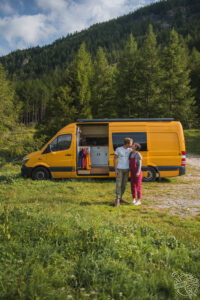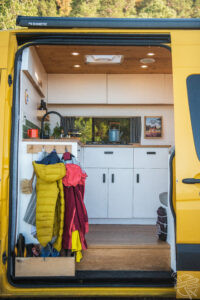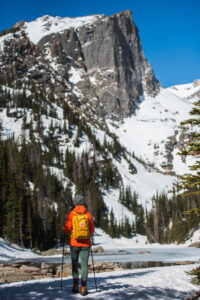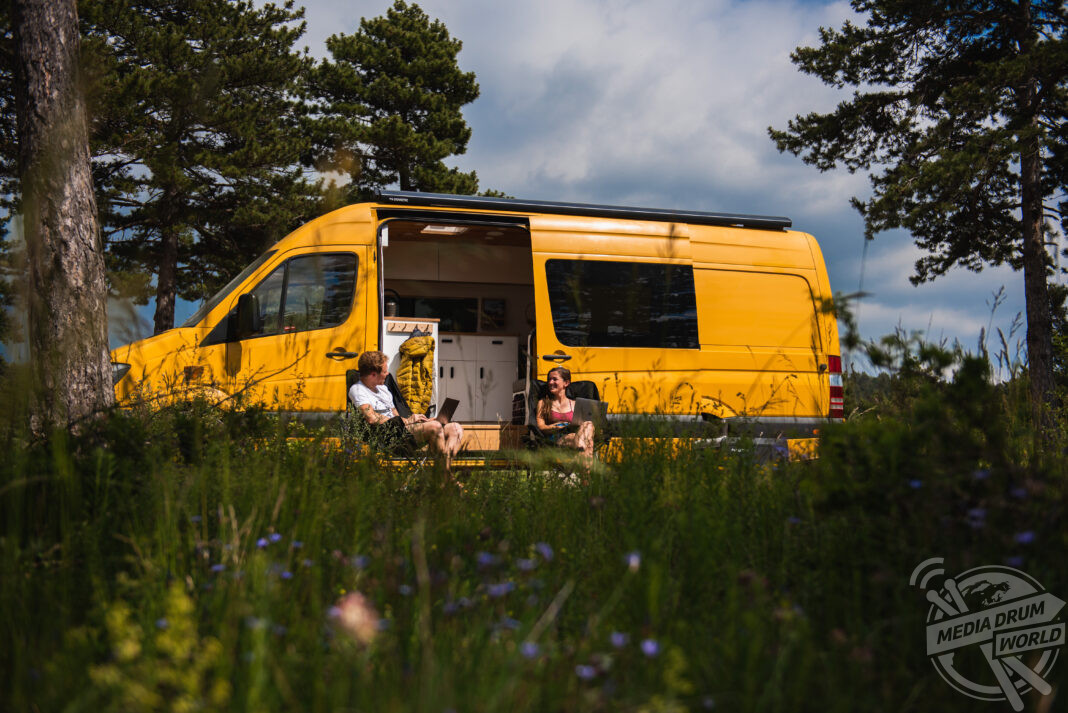**WITH FULL PERMISSIONS**
THIS COUPLE explained how they ditched the 9-to-5 for the open road – travelling 40,000 miles by turning their home on wheels into their dream job.
Directors of their company, Nomadic Energy Charlie Low (28) and Dale Comley (32) from Bristol met climbing in the Dolomites where after a whirlwind romantic fortnight in a small cabin together they knew they enjoyed shared dreams of how they both wanted to live.
Upon their return to the UK, the couple settled into a two-bed end terrace in Bristol, with Charlie working in data analysis and digital marketing for an adventure travel company while Dale was a Lead Engineer at Dyson.
They longed for a more proactive life of adventure, so in February 2019 they bought a bright yellow 2013 LWB Sprinter that they nicknamed “Ringo” for £7,800 and spent around £7,000 transforming it into their home on wheels.

With their eye on the open road COVID struck, and the couple’s dreams were put on hold. Instead of the next 12 months being their dream sabbatical, much of the year was spent unable to leave the house on furlough.
They decided to focus on a new project, taking everything they had learnt during the build, to write a definitive guide to converting a campervan, the book they wished they had when they converted their van.
This became a catalyst for them re-writing the way they live.
In April 2021 they published The Van Conversion Bible, quit their 9-5 office jobs, and moved into their campervan, all on pretty much the same day.
Since then they’ve never looked back, travelling first to Europe, and now the Americas, in their campervan, working and climbing wherever they travel. They have put around 40,000 miles on Ringo and show no signs of slowing down.
“We knew we wanted to live life differently, but we didn’t necessarily know what that looked like, so we’d planned to take a sabbatical and travel around Europe in a campervan for a year,” said Charlie.
“In February 2019 we took the plunge and bought a bright yellow ex-DHL Sprinter van, which we aptly named ‘Ringo’, think Mr Starr / ‘Yellow Submarine’ by The Beatles!
“Unfortunately for us, the completion of our conversion was timed almost perfectly with the start of the first UK lockdown, and our plans were thrown into disarray.
“Instead of the next 12 months being our dream sabbatical, instead much of the year was spent unable to leave the house, furloughed and feeling stuck.
“But neither of us are very good at sitting still and waiting, so instead we decided to focus on a new project, taking everything we had learnt during our build, as well as our backgrounds in physics and engineering, to write a definitive guide to converting a campervan.
“Living in a van has allowed us the time and headspace to develop some ideas we never would have had time for before, and turn them into a business.”
The pair always wanted to live differently they just did not realise that the nomad van life would become both their work and their pleasure when they started this journey.
“We started our conversion in February 2019 and finished in March 2020. So it took us just over a year, but this was while we were both working full-time office jobs,” said Charlie.
“The total time was around 1,000 hours.
“The incredible thing about van life is that it can have a profound impact on your living costs, and ergo your quality of life.
“Before we lived in a van, we were paying £1,000 per month on a mortgage, and another £800 each on food, fuel, and all the costs that come with living in a city like Bristol.

“Now we spend closer to £600 each per month, which includes all fuel, food and other costs such as internet and car insurance.
“We find that we spend most of our time in nature, up in the mountains and away from civilisation, so we don’t end up spending as much money on meals out or visiting cafes.
“We never stay on campsites as our electrical system is 100% off-grid, so we don’t have any ‘rent’ or utilities to pay, and our living costs are hugely reduced.
“We’ve been living in our van since April 2021, and in that time we’ve spent two years exploring Europe, and now we’re currently halfway through a Pan American road trip.
“So the total mileage is somewhere around 40,000.”

Charlie and Dale have faced both positive and negative reactions to their van lifestyle but they know it is what makes them happy right now and while they may not always live in a van they lifestyle is giving them what they need to be fulfilled now.
“It’s always interesting to see people’s take on living in this way. I guess because of the sort of places we travel to, most people are really interested to understand how we’ve managed to pivot our life to live in this way, and feel inspired,”shared Charlie.
“But there are always some people who can’t imagine being able to live without a full bathroom, washing machine and some home comforts they’re used to.
“Something really fun about bringing your house with you wherever you travel is that people are always really excited to see it.
“A lot of people still don’t know that you can live and travel in a van full-time, and when you explain to someone your story of how you came to live in this way, you can see it sometimes sparks a thought of how they could live differently too.”
Charlie and Dale want people to know it is not all as beautiful and picturesque as it may look on Instagram but if the lifestyle is for you just make sure you research first, even reach out to the couple, their company can help you.
“Our scariest moment was driving down a winding mountain road in the south of France. We must have missed a ‘max vehicle length’ sign, and as we made our way down the winding road towards the bottom of the valley, the hairpin bends got narrower and narrower,” they said.
“About two thirds of the way down we were having to do a three point turn on every corner, and suddenly the road was too steep and we weren’t able to reverse.
“There was a big drop in front of us, and the road was so steep that the handbrake wouldn’t hold the weight of the van.
“We ended up with Dale head under the steering wheel with his hands on the pedals, and Charlie on the handbrake and being our eyes. It was pretty scary and a high adrenaline moment for sure.
“When you look at pictures and videos of van life on Instagram, it can make it look idyllic. But it’s not always perfect, when your home is also a vehicle, a breakdown can suddenly become a lot more stressful.
“Getting stuck in mud or sand, not being able to park – there are a lot of potential problems that come with driving around in a 7m long 3.5T vehicle.
“And of course you are completely self-sufficient, not connected to any utilities, so this means frequent trips to fill up water, go to a laundrette, empty your toilet.
“The two key things you need to live in a van are a van and a remote / flexible job. If you’re just keen to have a break from work too that’s fine, maybe you just want to do a van trip for a few months, there isn’t one way of doing things.
“If that’s the case you just need to budget and save up enough.
“But if you want to live this way long term, as long as you can find a remote job, it’s such an easy way of living.
“Since COVID there are so many remote and flexible jobs around, it’s really opened up this way of living to so many more people.”
Charlie and Dale have lived the van life for almost three years and with this comes a wealth of knowledge and how to handle it, the comforts some people may require or not and importantly the cost of undertaking this lifestyle.
“We have an outdoor shower which is connected to our water and gas tanks. As soon as you turn it on, the water is instantly hot, so it’s just like having a shower at home , except outside,” shared the couple.
“For us this was the best option, as we didn’t need to use up any valuable indoor space with a bathroom cubicle.
“Depending on where you travel, finding potable water can be tricky. We have a UV and particulate water filter in-line before our tap, so that even if we fill up from somewhere that’s not ‘drinking water’ it still won’t be an issue.
“You can also purchase a low cost water filter like the LifeStraw which is a great option to ensure the water you’re drinking is clean.
“Our electrical system is fully off-grid, so we recharge our batteries from solar and whilst we drive. We have a pretty large battery bank as we run our business from our van, so it needs to be reliable.

“We need to be able to charge our laptops and run our Starlink satellite internet dish, 100% necessary for working remotely in the US and South America.
“Not only that, but as we spend a lot of time off-grid, we like to stock up from the supermarket for a week or 2, so we have a pretty big fridge.
“Between our B2B which runs from our alternator as we drive and our solar panels, we never have any issues with generating enough power.
“We have a four ring gas hob in our van, exactly the same as you’d have in a house. We have a pretty big kitchen, with a Belfast sink, so we have lots of room to cook.
“We have a big underslung LPG tank which we refill every 3-4 months, and this feeds our hob, shower and heater.”
“Expenses are different depending on where you travel,” explain the couple.
They provide a breakdown for the UK and Europe:
Insurance – £700 per annum
Food – £500 per month
Fuel – £100-£300 per month
Internet – £30-£80 per month
LPG – £15 every quarter.
The couple share their Van Conversion Bible for anyone considering the lifestyle along with their Nomadic Energy that can help you make off grid energy simple on their website.
ENDS










